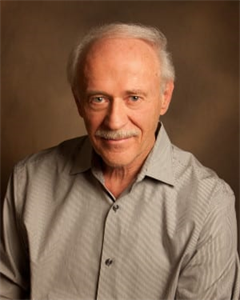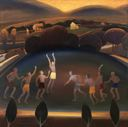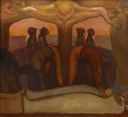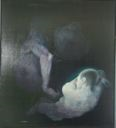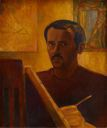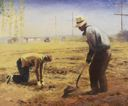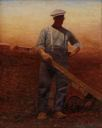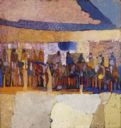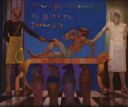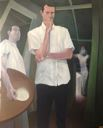Gary Ernest Smith
(Baker, Oregon, 1943 - )
Gary Ernest Smith was born in the rural Eastern Oregon community of Baker, in 1942. He attended Eastern Oregon State College and Brigham Young University, from which he earned a Master of Fine Arts degree. He served in the United States Army for two years as an illustrator, and he was on the faculty at BYU and acted as gallery director for three terms. Smith has been self-employed as an artist since 1972. He and his wife, Judy Asay Smith, have four children and live in the arts community of Highland, Utah. Gary Smith presents impressive credentials as an artist. Though famous for his paintings, in recent years he has also turned his talents to sculpture. His paintings, some of which depict rural America from the turn of the century to the present, and others, which depict early Utah and Oregon 20th-century life, hang in museums, in private, corporate, and university collections, as well as in churches along the Wasatch front. He is extensively published as an illustrator and has received many major commissions for his paintings and sculptures. Dr. Vern Swanson, of the Springville Museum of Art, describes Smith as "constantly seeking his ends through stylistic experiment." Smith strives for simple, direct statements that capture the essential character of his subject: icon and image are more important than explicit detail. "Large bold shapes, " Smith says, "with minimal detail, are the substance of my work. Most of the detailing in my pictures is 'implied' rather than painted." Termed a neo-regionalist, Smith works on the basis of reinterpretation of rural, mid-america themes. While acknowledging the appropriateness of the term, he also feels it's too limiting. As an artist he concentrates on spatial and coloristic solutions, and his themes are often spiritual, though the interpretation is clearly unique in form and style. The subjects of Gary Smith's art lie in three major areas--overt and latent religious subjects, landscapes, and evocations of the rural west, each born from poignant personal experiences in his life. Smith admits to being a "driven painter" who needs the distractions of his musician wife and his children to rescue him from spending all day in the studio. He attributes this work ethic to his upbringing. With his brothers and father, Smith worked on the family cattle ranch and farm. "Farming is hard work; I didn't want to do that the rest of my life, " he says. " I wanted more. I wanted to be an artist. I had no idea what that entailed-- it was a dream, kind of an unreachable dream." Gary Smith has obviously reached his dream. "Art is a way of addressing humanity, " Smith says, " and my works attempt to merge ideas and memories." Smith believes, "Good art functions on many levels. There is the surface appeal of subject, and below that are layers that may be peeled off, revealing information about the individual artist and the psychology of his era. There's the subject but there's also the underlying theme." Smith also says his "... art is a constant struggle for the new insight, for the more effective technique. It is as changing and evolving as life itself. To unite humanity with the earth through art is like combining the body with the spirit." Theodore F. Wolff, art editor for the Christian Science Monitor, says of Gary Smith, Few artists today see things whole. Most prefer a sliver of the truth and an art defined by theory, passion or imitation. Not so Gary E. Smith. For him art is expansive and holistic, ideal for sharing what is good, beautiful and true, and the best way to communicate one's deepest beliefs and intuitions. Gary Smith's recent exhibit, "Fields," at the Springville Museum of Art, centers on eight large canvases (he has since added to the suite) that show fields in various seasons and stages--one is of plowed ground with a dusting of snow, another of a harvested field with a few scattered bales of hay, and another has furrows echoing the contours of the rolling hills. At the opening for the exhibit, Smith asked for a response to his pieces. One individual said "I think you feel the same way about the land I do, but most people overlook over such kinds of beauty and never see it." Smith agreed that most people don't see empty fields as beautiful, and says that is why he painted these. And it's working, he says; people have come in (to the show) and looked around for a while and then come up to him to tell him about a field he needs to see--their eyes have been opened. That personal insight Smith struggles to attain and to share has successfully expanded to encompass the viewers of his paintings. Careful observers walk away from his paintings with a broader, more appreciative view of beauty and of the goodness of the earth and the people who work it, and of this artist, who paints it.
(Baker, Oregon, 1943 - )
Gary Ernest Smith was born in the rural Eastern Oregon community of Baker, in 1942. He attended Eastern Oregon State College and Brigham Young University, from which he earned a Master of Fine Arts degree. He served in the United States Army for two years as an illustrator, and he was on the faculty at BYU and acted as gallery director for three terms. Smith has been self-employed as an artist since 1972. He and his wife, Judy Asay Smith, have four children and live in the arts community of Highland, Utah. Gary Smith presents impressive credentials as an artist. Though famous for his paintings, in recent years he has also turned his talents to sculpture. His paintings, some of which depict rural America from the turn of the century to the present, and others, which depict early Utah and Oregon 20th-century life, hang in museums, in private, corporate, and university collections, as well as in churches along the Wasatch front. He is extensively published as an illustrator and has received many major commissions for his paintings and sculptures. Dr. Vern Swanson, of the Springville Museum of Art, describes Smith as "constantly seeking his ends through stylistic experiment." Smith strives for simple, direct statements that capture the essential character of his subject: icon and image are more important than explicit detail. "Large bold shapes, " Smith says, "with minimal detail, are the substance of my work. Most of the detailing in my pictures is 'implied' rather than painted." Termed a neo-regionalist, Smith works on the basis of reinterpretation of rural, mid-america themes. While acknowledging the appropriateness of the term, he also feels it's too limiting. As an artist he concentrates on spatial and coloristic solutions, and his themes are often spiritual, though the interpretation is clearly unique in form and style. The subjects of Gary Smith's art lie in three major areas--overt and latent religious subjects, landscapes, and evocations of the rural west, each born from poignant personal experiences in his life. Smith admits to being a "driven painter" who needs the distractions of his musician wife and his children to rescue him from spending all day in the studio. He attributes this work ethic to his upbringing. With his brothers and father, Smith worked on the family cattle ranch and farm. "Farming is hard work; I didn't want to do that the rest of my life, " he says. " I wanted more. I wanted to be an artist. I had no idea what that entailed-- it was a dream, kind of an unreachable dream." Gary Smith has obviously reached his dream. "Art is a way of addressing humanity, " Smith says, " and my works attempt to merge ideas and memories." Smith believes, "Good art functions on many levels. There is the surface appeal of subject, and below that are layers that may be peeled off, revealing information about the individual artist and the psychology of his era. There's the subject but there's also the underlying theme." Smith also says his "... art is a constant struggle for the new insight, for the more effective technique. It is as changing and evolving as life itself. To unite humanity with the earth through art is like combining the body with the spirit." Theodore F. Wolff, art editor for the Christian Science Monitor, says of Gary Smith, Few artists today see things whole. Most prefer a sliver of the truth and an art defined by theory, passion or imitation. Not so Gary E. Smith. For him art is expansive and holistic, ideal for sharing what is good, beautiful and true, and the best way to communicate one's deepest beliefs and intuitions. Gary Smith's recent exhibit, "Fields," at the Springville Museum of Art, centers on eight large canvases (he has since added to the suite) that show fields in various seasons and stages--one is of plowed ground with a dusting of snow, another of a harvested field with a few scattered bales of hay, and another has furrows echoing the contours of the rolling hills. At the opening for the exhibit, Smith asked for a response to his pieces. One individual said "I think you feel the same way about the land I do, but most people overlook over such kinds of beauty and never see it." Smith agreed that most people don't see empty fields as beautiful, and says that is why he painted these. And it's working, he says; people have come in (to the show) and looked around for a while and then come up to him to tell him about a field he needs to see--their eyes have been opened. That personal insight Smith struggles to attain and to share has successfully expanded to encompass the viewers of his paintings. Careful observers walk away from his paintings with a broader, more appreciative view of beauty and of the goodness of the earth and the people who work it, and of this artist, who paints it.
Artist Objects
